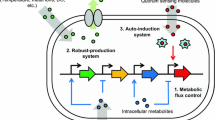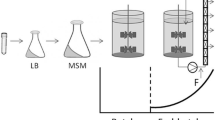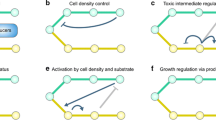Abstract
Four decades of work have clearly established the existence of autonomous oscillations in budding yeast culture across a range of operational parameters and in a few strains. Autonomous oscillations impact substrate conversion to biomass and products. Relatively little work has been done to quantify yield in this case. We have analyzed the yield of autonomously oscillating systems, grown under different conditions, and demonstrate that it too oscillates. Using experimental data and mathematical models of yeast growth and division, we demonstrate strategies to increase the efficient recovery of products. The analysis makes advantage of the population structure and synchrony of the system and our ability to target production within the cell cycle. While oscillatory phenomena in culture have generally been regarded with trepidation in the engineering art of bioprocess control, our results provide further evidence that autonomously oscillating systems can be a powerful tool, rather than an obstruction.









Similar content being viewed by others
References
Dumas, B., Masson, C., Lebrun, K., & Achstetter, T. (2006). Hydrocortisone made in yeast: metabolic engineering turns a unicellular microorganism into a drug-synthesis factory. Biotechnology Journal, 1, 299–307.
Kjeldsen, T., Ludvigsen, S., Diers, I., Balshmidt, P., Sorensen, A., & Kaarshold, N. (2002). Engineering-enhanced protein secretory expression in yeast with applications to insulin. Journal of Biological Chemistry, 277, 18245–18248.
Szczebara, F., Changelier, C., Villeret, C., Masurel, C., Masurel, A., Bourot, S., et al. (2003). Total biosynthesis of hydrocortisone from a simple carbon source in yeast. Nature, 21, 143–149.
Thim, L., Hansen, M., Norris, K., Holegh, I., Boel, E., Forstrom, J., et al. (1986). Secretion and processing of insulin precursors in yeast. PNAS, 83, 6766–6770.
Chan, E., Chen, C., & Chen, L. (1992). Recovery of invertase from ethanol fermentation broth. Biotechnology Letters, 14, 573–576.
Uchiyama, K., Morimoto, M., Yokoyama, Y., & Shioya, S. (1996). Cell cycle dependency of rice α-amylase production in a recombinant yeast. Biotechnology and Bioengineering, 54, 262–271.
Bansal, V., Roychoudhurry, P., Mattiasson, B., & Kumar, A. (2006). Recovery of urokinase from integrated mammalian cell culture cryogel bioreactor and purification of the enzyme using p-aminobenzamidine affinity chromatography. Journal of Molecular Recognition, 19, 332–339.
Sajc, L., Grubisic, D., & Novakovic, G. (2000). Bioreactors for plant engineering: An outlook for further research. Biochemical Engineering Journal, 4, 89–99.
Smith, C. (2005). Striving for purity: Advances in protein purification. Nature, 2, 71–77.
Stowers, C., & Boczko, E. M. (2007). Reliable cell disruption in yeast. Yeast, 24, 533–541.
Gleeson, M., White, C., Meininger, D., & Komives, A. (1998). Generation of protease-deficient strains and their use in heterologous protein expression. Methods in Molecular Biology, 103, 81–94.
Alberghina, L., Mariani, L., Martegani, E., & Vanoni, M. (1983). Analysis of protein distribution in budding yeast. Biotechnology and Bioengineering, 15, 1295–1310.
Vanoni, M., Vai, M., Popolo, L., & Alberghina, L. (1983). Structural heterogeneity in populations of budding yeast Saccharomyces cerevisiae. Journal of Bacteriology, 156, 1282–1291.
Hortso, M. (1996). Population balance models of autonomous periodic dynamics in microbial cultures: Their use in process optimization. Canadian Journal of Chemical Engineering, 74, 612–620.
Walker, G. (1999). Synchronization of yeast cell populations. Methods in Cell Science, 21, 87–93.
Stowers, C., Hackworth, D., Mischaikow, K., Gedeon, T., & Boczko, E. (2008). Extending synchrony and deconvolving population effects in budding yeast through an analysis of volume growth with a structured Leslie model. Theoretical Population Biology (in press).
Richard, P. (2003). The rhythm of yeast. FEMS Microbiology Reviews, 27, 547–557.
Dawson, P. (1972). Continuous synchronous culture—The production of extracellular enzymes by continuous phased culture of Bacillus subtilis. Proceedings of the IV IFS: Ferment. Technol. Today, pp. 121–128.
Jules, M., Francois, J., & Parrou, J. (2005). Autonomous oscillations in Saccharomyces cerevisiae during batch cultures of trehalose. FEBS Journal, 272, 1490–1500.
Bellgardt, K. H. (1994). Analysis of synchronous growth of bakers yeast. Part I: Development of a theoretical model for sustained oscillations. Journal of Biotechnology, 35, 19–33.
Bellgardt, K. H. (1994). Analysis of synchronous growth of bakers yeast. Part II: Development of a theoretical model for sustained oscillations. Journal of Biotechnology, 35, 35–49.
Beuse, M., Bartling, R., Kopmann, A., Deikmann, H., & Thoma, M. (1998). Effect of the dilution rate on the mode of oscillation in continuous cultures of Saccharomyces cerevisiae. Journal of Biotechnology, 61, 15–31.
Crooke, P., Tanner, R., & Park, D. (1986). Time dependent differential yield as a scale-up parameter in enzyme and fermentation reactors. Biotechnology Progress, 2, 40–47.
Essajee, C., & Tanner, R. D. (1979). The effect of extracellular variables on the stability of continuous baker’s yeast–ethanol fermentation process. Process Biochemistry, 25, 16–21.
Heinzle, E., Dunn, I., Furukawa, K., & Tanner, R. D. (1982). Modeling of sustained oscillations observed in continuous culture of Saccharomyces cerevisiae. In A. Halme (Ed.), Proceedings of the 1st IFAC Workshop (pp. 57–65). Oxford: Pergamon.
Murray, D., Klevecz, R., & Lloyd, D. (2003). Generation and maintenance of synchrony in Saccharomyces cerevisiae continuous culture. Experimental Cell Research, 287, 10–15.
Tu, B. P., Kudlicki, A., Rowicka, M., & McKnight, S. L. (2006). Logic of the yeast metabolic cycle: Temporal compartmentalization of cellular processes. Science, 310, 1152–1158.
Xu, Z., & Tsurugi, K. (2006). A potential mechanism of energy-metabolism oscillation in an aerobic chemostat culture of the yeast Saccharomyces cerevisiae. FEBS Journal, 273, 1696–1709.
Aldridge, S. (1996). Downstream processing needs a boost. Genetic Engineering and Biotechnology News, 26, 1.
Ramesh, M., Charyulu, N., Chand, N., & Lonsane, B. (2004). Non-growth associated production of enzymes in solid state fermentation systems: Its mathematical description for two enzymes produced by Bacillus licheniformis. Bioprocess and Biosystems Engineering, 15, 289–294.
Cos, O., Ramon, R., Luis Montesinos, J. L., & Valero, F. (2006). Operational strategies, monitoring and control of heterologous protein production in the methylotrophis yeast Pichia pastoris under different promoters: a review. Microbial Cell Factories, 5, 17.
Taufer, M., An, C., Kerstens, A., & Brooks, C. (2006). Predictor @ home: A “protein structure prediction supercomputer” based on global computing. IEEE Transactions on Parallel and Distributed Systems, 17, 786–796.
Qui, J., & Noble, W. (2008). Predicting co-complexed protein pairs from heterogeneous data. PLOS Computation Biology, 4, e1000054.
Hartwell, L. (1974). Saccharomyces cerevisiae cell cycle. Bacteriological Reviews, 38, 164–198.
Hartwell, L., & Unger, M. (1977). Unequal division in Saccharomyces cerevisiae and its implications for the control of the cell division. Journal of Cell Biology, 75, 422–435.
Acknowledgments
The authors would like to thank Peter Kotter from Johan Wolfgang Goethe-University for providing the yeast strain CEN.PK.113-7D and Rick Haselton for helpful discussion and generous use of his lab.
Author information
Authors and Affiliations
Corresponding author
Appendices
Appendix 1: Asymptotic Periodicity
Let the population density be periodic with period T. This means that P(t + T,s) = p(t) for all s. From this, it follows that I(t) is periodic with period T:
where we have used the inner product notation to represent the integrals from Eq. 4. Now consider the function F(t). Using the well-known variation of parameters solution of Eq. 5, we have that
Using the periodicity of I, we have:
Since the last integrand is finite and e −Dt limits to 0 exponentially as t goes to ∞, F(t) is an asymptotically periodic with period T.
Appendix 2: Leslie Model of Yeast Growth and Division
where:
The Leslie model [16] used to calculate yeast growth and division encodes as a mathematical object the process flow depicted at the top of Fig. 10. The process flow has age descending from daughter cells with no scars, P 0, at the top to cells with arbitrarily many scars, P n, at the bottom. Cells belonging to each of these age classes traverse their separate cell cycles, shown as the horizontal thick black lines. The time it takes a cell of age, k, to traverse their cell cycle is τ k. The values of τ used are shown in Table 3 along with the temporal position of bud emergence. The thin black lines with arrows indicate the directions of possible flux due to cell divisions. Each arrow corresponds to a 1 in the matrix representation of the process at the bottom of Fig. 10.
The top schematic represents the process of yeast growth and division. Each age class is represented by a bold horizontal line and corresponding residence time, τ. The age classes are organized by replicative age, with the daughter cells, denoted P0, as the first grid. Higher generation parent cells are listed below. Each cell division can be characterized by producing a daughter cell back at the beginning of the P0 grid and a parent of the next highest age class. This process can be represented by a Leslie matrix as shown by the bottom panel
Given an initial population distribution, the matrix model is iterated to produce the dynamics. Typically, such a system would produce asynchronous exponential growth. Autonomous oscillations result from an additional feedback. We have introduced a delay model to produce population oscillation. In the delay model, a threshold, T R, is introduced. Once the density of cell in the S-phase of the cell cycle reaches T R or above, any cells in a 10% strip proximal to S become delayed in their cell cycle progression. In the simulations described in Fig. 8, T R was 20% of the total culture density. The S-phase is delimited on the left by bud emergence (BE) as described in Table 3. The algorithm used to implement this model is freely available from the authors upon request.
Rights and permissions
About this article
Cite this article
Stowers, C.C., Robertson, J.B., Ban, H. et al. Periodic Fermentor Yield and Enhanced Product Enrichment from Autonomous Oscillations. Appl Biochem Biotechnol 156, 59–75 (2009). https://doi.org/10.1007/s12010-008-8486-7
Received:
Accepted:
Published:
Issue Date:
DOI: https://doi.org/10.1007/s12010-008-8486-7





